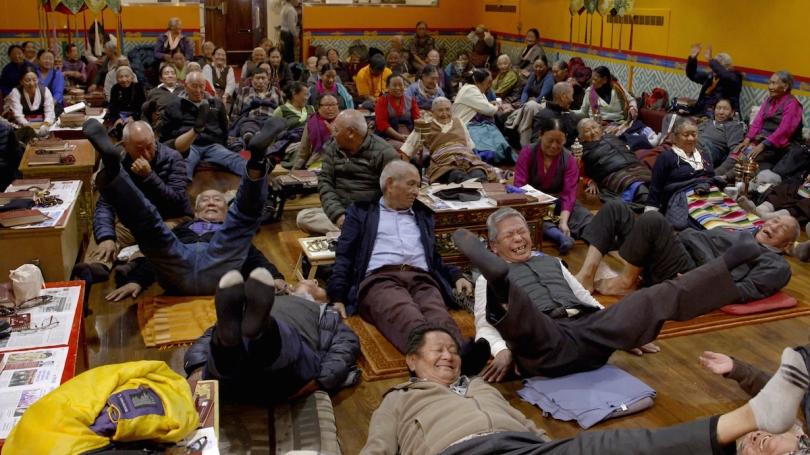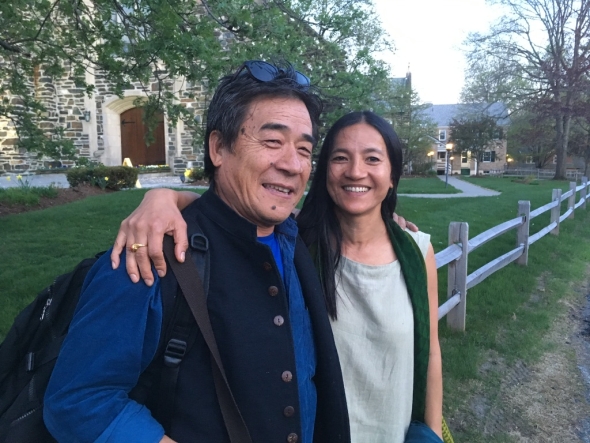

Directed by celebrated Tibetan filmmaker Kesang Tseten, the film builds on Craig's research on migration and social change to showcase one of New York's newest immigrant communities.
On Nov. 12, a documentary co-produced by anthropology professor Sienna Craig will premiere at DOC NYC, the largest documentary film festival in the country.
Directed by Tibetan filmmaker Kesang Tseten and informed by Craig's research on migration and social change, Diversity Plaza showcases a community of Himalayan and Tibetan immigrants in the Jackson Heights neighborhood of Queens, N.Y.—an area often referred to as the most diverse zip code in America. In recent decades, tens of thousands of people from Nepal, northern India, Bhutan, and the Tibetan areas of China have migrated to Queens and Brooklyn, making New York City a major hub for the greater Himalayan diaspora.
Craig and Tseten will take part in a Q&A at DOC NYC following screenings of the film on Nov. 12 and 14.
Diversity Plaza draws inspiration from filmmaker Frederick Wiseman's cinéma vérité aesthetic and the legendary documentarian's 2015 film, In Jackson Heights—which paints a vivid portrait of the area, yet does not highlight residents from Tibet or the Himalaya.

"This community has been visibly invisible in the larger context of immigrant New York," says Craig, who holds the Orvil Dryfoos Professorship in Public Affairs. "This was a point of inspiration for the film. Until recently, elected politicians and city officials didn't really know this constituency. In many ways, Kesang is both taking inspiration from Wiseman's film and answering it, capturing a part of this story that he didn't see."
Diversity Plaza takes place during the buildup to the 2020 U.S. Census and heated presidential election at a moment when Jackson Heights was at the epicenter of the COVID-19 pandemic. Tseten spent a year observing Himalayan immigrants' community and culture, as well as visits from their political representatives, including U.S. Rep. Alexandria Ocasio-Cortez, D-N.Y.
"The documentary helps to capture all these inflection points and their relationship to each other—the idea of New York as a sanctuary city, the long history of immigration in a place like Jackson Heights, the precarity and vulnerability of people who are marginalized in many ways, some of them undocumented and many of them serving as essential workers," Craig says.
"We also want to tell a larger story through the lens of Tibetan and Himalayan New Yorkers about the challenges and the beauty of cultivating belonging through experiences of displacement, and finding a sense of home, care, and connection in spite of—or even through—experience of suffering and trauma that led people to leave Asia for New York."
From Nepal to Dartmouth
Craig first met Tseten nearly two decades ago, when she was conducting ethnographic research in Nepal. Back in Hanover, Craig became friends with Tseten's late older brother, Kesang Tashi '70, who was the first Tibetan to graduate from Dartmouth and later owned a Tibetan rug store on Main Street.

In 2018, three years after Nepal suffered a series of devastating earthquakes, Craig invited Tseten and Tibetan poet Tsering Wangmo Dhompa to Dartmouth to serve as artists in residence and take part in a number of activities with South House, where Craig serves as house professor. In a packed Loew Auditorium, Tseten screened and discussed his film Trembling Mountain, which tells the Langtang Valley's story of disaster, survival, and rebuilding.
A few years earlier, Craig had worked with fellow scholars affiliated with the Endangered Language Alliance, a nonprofit based in New York City, to launch Voices of the Himalaya, which documents the languages, cultures, and community life of Himalayan New Yorkers through more than 20 online videos.
The series features people talking about their past lives and immigration experiences in more than a dozen endangered Himalayan languages and dialects. Viewed hundreds of thousands of times around the world, especially by members of New York's Himalayan community and "home" communities in Asia, the videos document sociolinguistic diversity and "amplify voices that would otherwise be lost," says Craig.
Craig and her collaborators asked Tseten to utilize the footage to make a mini-documentary, which piqued his interest and ultimately led him to propose a full-length film about Himalayan and Tibetan New York.
Meanwhile, the COVID-19 pandemic had begun, and Jackson Heights, especially Elmhurst Hospital, was at its epicenter.
Craig and her fellow researchers pivoted from video to audio and followed up with several interviewees from Voices of the Himalaya to create a series of "pandemic diaries." The scholars also interviewed community leaders who were helping people navigate the pandemic, all the while supporting Tseten with contacts and logistics for Diversity Plaza.
"We sought to illuminate the important sociocultural and even spiritual framings that were enabling people to survive the pandemic and create networks of mutual aid," Craig says.
This winter, Craig plans to coordinate a public screening of the documentary at Dartmouth in conjunction with the course she is teaching, Anthropology of Tibet and the Himalayas, and in collaboration with South House and the Department of Asian Societies, Languages, and Cultures, where she is a faculty affiliate.
'No one way to tell a story'
Beginning with her 2008 book, Horses Like Lightning, which combines memoir and cultural exploration in narrating her first visit to Nepal at age 19, Craig has cultivated an anthropologic practice that embraces storytelling across genres.
"One of the beautiful parts of being an anthropologist is realizing that there is no one way to tell a story," Craig says. "And there is never only one story. In some contexts, a traditional academic paper might be just the thing, but in others, maybe film, a children's book, photography, poetry, or some combination might be the way to get at the messy and complicated truths of the human condition, and to the ethics of representing other people's lives."
Diversity Plaza and Voices of the Himalaya intersect with research Craig conducted for her 2020 book, The Ends of Kinship: Connecting Himalayan Lives Between Nepal and New York. The book combines ethnography and short fiction in an exploration of the dynamics of migration, and how individuals, families, and communities carve out spaces of belonging.
Craig points out that anthropology has evolved as a discipline over the last few decades to embrace multi-vocality and multimodal forms more fully.
"Such approaches makes knowledge production not only more collaborative but also opens up the capacity for people who are not academics to benefit," Craig says. "This includes the creation of outputs that speak to communities themselves and meet their needs."
Voices of the Himalaya and the COVID diaries project, for example, serve as resources for Himalayan New Yorkers, representing what Craig calls "citizen ethnography"— "self-representation of lived experiences around migration and social change."
Craig hopes that Diversity Plaza will help Himalayan New Yorkers advocate for resources and recognition as they continue to live their lives amid a complex set of circumstances.
One scene in the documentary shows a Sunday school where children learn Tibetan and Nepali customs and traditional songs from older members of the community. Students and teachers from one of the classes will attend the film's premiere at DOC NYC.
"We hope that generations of Himalayan New Yorkers will see themselves in the film and feel validated and celebrated," Craig says.